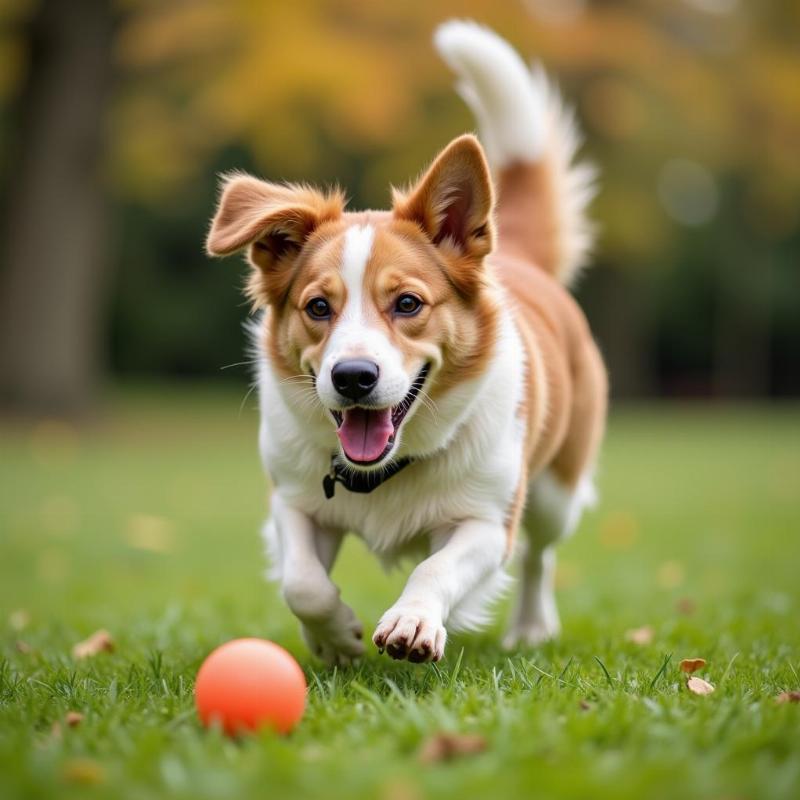It can be endearing, even flattering, when your dog follows you everywhere. But sometimes, that constant companionship can become a bit much. If you’re wondering, “why won’t my dog leave me alone?” you’re not alone. Many dog owners experience this, and understanding the reasons behind this clingy behavior is the first step to addressing it. This article will explore the common causes of canine clinginess, from separation anxiety to boredom, and provide practical solutions for encouraging a more independent pup while maintaining a healthy, loving bond.
Decoding Your Dog’s Clinginess: Common Causes
Several factors can contribute to a dog’s velcro-like attachment to their owner. Pinpointing the root cause is crucial for implementing effective strategies. Is it separation anxiety, a lack of proper training, or simply a breed trait? Let’s delve into the possibilities.
Separation Anxiety: More Than Just Clinginess
Separation anxiety in dogs is a serious behavioral issue that goes beyond simple clinginess. It manifests as extreme distress when the dog is left alone or separated from their owner. Symptoms can range from excessive barking and howling to destructive behavior and even self-harm. If you suspect your dog’s clinginess stems from separation anxiety, consult with a certified professional dog trainer or a veterinary behaviorist for guidance.
Boredom and Lack of Stimulation: A Recipe for Clinginess
A bored dog is a clingy dog. If your dog isn’t getting enough physical exercise and mental stimulation, they’ll likely seek attention by following you around. Think of it this way – if you were stuck inside all day with nothing to do, you’d probably want some company too! Regular walks, playtime, and puzzle toys can work wonders in alleviating boredom-induced clinginess.
Breed-Specific Traits: Some Dogs Are Just Clingier
Certain breeds, like Velcro dogs such as Cavalier King Charles Spaniels and Italian Greyhounds, are naturally more predisposed to clinginess. These breeds were often bred as companion animals and thrive on human interaction. While you can’t change a dog’s inherent nature, you can manage their clinginess through training and providing a stimulating environment.
Fostering Independence: Practical Tips and Training Techniques
Now that we’ve explored the potential reasons behind your dog’s clinginess, let’s discuss some practical solutions. Remember, patience and consistency are key to achieving positive results.
Establish a Safe Space: The Power of the Den
Creating a den-like environment, such as a crate or dog bed in a quiet corner, can provide your dog with a sense of security and help them learn to self-soothe. Make this space inviting with comfortable bedding and their favorite toys. Encourage your dog to spend time in their den, even when you’re home, by rewarding them with treats and praise.
Gradual Desensitization: Baby Steps to Independence
If your dog suffers from separation anxiety, gradual desensitization is a crucial training technique. Start by leaving your dog alone for very short periods, gradually increasing the duration as they become more comfortable. Ensure your departures and arrivals are low-key, avoiding excessive fuss or attention.
Positive Reinforcement: Reward Independence
Rewarding independent behavior is essential for fostering self-reliance. When your dog chooses to settle down on their own, rather than following you around, offer praise and a small treat. This positive reinforcement helps them associate independent behavior with positive outcomes.
Addressing “Why Won’t My Dog Leave Me Alone?”: A Multifaceted Approach
Understanding why your dog won’t leave you alone requires a holistic approach, considering factors like anxiety, boredom, and breed traits. By addressing the underlying cause and implementing consistent training techniques, you can help your dog develop a sense of independence while maintaining a strong and loving bond.
FAQs:
- Is it bad if my dog follows me everywhere? Not always. It can be a sign of affection, but excessive clinginess may indicate underlying anxiety or boredom.
- How do I train my dog to be less clingy? Establish a safe space, practice gradual desensitization, and reward independent behavior with positive reinforcement.
- What if my dog’s clinginess is caused by separation anxiety? Consult with a certified professional dog trainer or veterinary behaviorist for guidance and a tailored training plan.
- Can certain breeds be more clingy than others? Yes, some breeds are naturally more predisposed to clinginess due to their breeding history.
- How can I tell the difference between normal clinginess and separation anxiety? Separation anxiety involves extreme distress and disruptive behavior when left alone, while normal clinginess is less intense.
- What are some signs of boredom in dogs? Excessive barking, destructive chewing, following you constantly, and general restlessness can all be indicators of boredom.
- How much exercise does my dog need to prevent boredom and clinginess? The amount of exercise varies depending on breed, age, and energy level. Consult with your veterinarian for personalized recommendations.
 Dog playing fetch in a park
Dog playing fetch in a park
Related Articles You Might Find Helpful:
- my dog won’t leave me alone
- my dog won t leave me alone
- my dog won’t leave me alone am i dying
- how to discipline a dog for getting in the trash
Beautdogs.us is your premier online resource for all things dog-related in the US. We offer expert advice on dog breeds, care, training, and the latest products and services. Whether you’re a new dog owner or a seasoned pro, Beautdogs.us is your trusted source for comprehensive and engaging information on canine companionship. Contact us today for personalized support and guidance: Email: [email protected], Phone: +1 501-555-7529. Visit Beautdogs.us for more information!